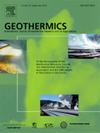Syn- to post-rift thermal evolution of the Pechelbronn sub-basin (Upper Rhine Graben)
IF 3.5
2区 工程技术
Q3 ENERGY & FUELS
引用次数: 0
Abstract
The Upper Rhine Graben (URG) is a key target for geothermal projects in Western Europe, requiring an understanding of the development and spatial evolution of geothermal fluids. Its thermal and geological history was impacted during the Neogene period by a major change in rift kinematics, evidenced by a regional-scale and gradual erosive unconformity and coeval volcanic activity. This study investigates the interplay between URG syn- and post-rift burial history and heat flow evolution in the westerly Pechelbronn sub-basin - hosting petroleum and geothermal fields – in comparison to the more central Rastatt Trough. The method uses thermal maturity assessment by vitrinite reflectance and 2D burial coupled to conductive thermal modelling. Results reveal that the maximum burial occurs during the Aquitanian (post-rift), and that the maximum cumulative sediment thickness related to the Neogene erosion was approximately 1200 m in the Pechelbronn sub-basin, from the top of the Schistes à Poissons (Rupelian shale) to the Aquitanian sediments. Toarcian source rock (Schistes carton) reached the oil window at 29–28 Ma within the Pechelbronn sub-basin and at 43 Ma for the Rastatt Trough at Roeschwoog well. The comparison of current adjacent local heat anomalies reveals variations in thermal history of the Pechelbronn sub-basin, highlighting the dominant influence of syn-rift burial in some areas, e.g. in Soultz-sous-Forêts or additional heat input attributed to geothermal fluids in others, e.g. in Rittershoffen. Moreover, it appears that the heat flow must have been considerably higher (around 180 mW/m², under the pure conduction hypothesis) during faults activation around 15 Ma in the Rittershoffen area, compared to Soultz-sous-Forêts (150 mW/m²). Changes in local heat flows are attributed to east-west migration of hydrothermal cells positions through time in relationship to fluid circulation at basin scale. These results provide a broad geological time frame for further thermal modeling in the URG and provide new insights into the thermal evolution of the URG and its implications for sub-surface resources exploration.
上莱茵地堑Pechelbronn次盆地裂谷同后热演化
上莱茵地堑(URG)是西欧地热项目的关键目标,需要了解地热流体的发展和空间演化。新近纪裂谷运动的重大变化对其热地质历史产生了影响,表现为区域尺度的逐渐侵蚀不整合和同时期的火山活动。本研究探讨了西部Pechelbronn次盆地(含油气和地热田)与更中心的Rastatt海槽的URG同步和裂谷后埋藏史与热流演化之间的相互作用。该方法采用镜质组反射率和二维埋藏相结合的导热模拟来评估热成熟度。结果表明,Pechelbronn次盆地从Schistes - Poissons (Rupelian页岩)顶部到阿基坦期沉积物,最大埋藏期为阿基坦期(后裂谷期),与新近纪侵蚀有关的最大累积沉积厚度约为1200 m。Toarcian烃源岩(Schistes carton)在Pechelbronn次盆地29 ~ 28 Ma到达油窗,Roeschwoog井Rastatt槽43 Ma到达油窗。当前邻近局部热异常的对比揭示了Pechelbronn次盆地热史的变化,突出了同裂谷埋藏在某些地区(如Soultz-sous-Forêts)的主导影响,或在其他地区(如Rittershoffen)归因于地热流体的额外热输入。此外,与Soultz-sous-Forêts (150 mW/m²)相比,在Rittershoffen地区的断层激活期间,热流似乎要高得多(在纯传导假设下,约为180 mW/m²)。局部热流的变化与盆地尺度上的流体环流有关,主要归因于热液细胞位置随时间的东西向迁移。这些结果为URG的进一步热模拟提供了一个广泛的地质时间框架,并为URG的热演化及其对地下资源勘探的影响提供了新的见解。
本文章由计算机程序翻译,如有差异,请以英文原文为准。
求助全文
约1分钟内获得全文
求助全文
来源期刊

Geothermics
工程技术-地球科学综合
CiteScore
7.70
自引率
15.40%
发文量
237
审稿时长
4.5 months
期刊介绍:
Geothermics is an international journal devoted to the research and development of geothermal energy. The International Board of Editors of Geothermics, which comprises specialists in the various aspects of geothermal resources, exploration and development, guarantees the balanced, comprehensive view of scientific and technological developments in this promising energy field.
It promulgates the state of the art and science of geothermal energy, its exploration and exploitation through a regular exchange of information from all parts of the world. The journal publishes articles dealing with the theory, exploration techniques and all aspects of the utilization of geothermal resources. Geothermics serves as the scientific house, or exchange medium, through which the growing community of geothermal specialists can provide and receive information.
 求助内容:
求助内容: 应助结果提醒方式:
应助结果提醒方式:


